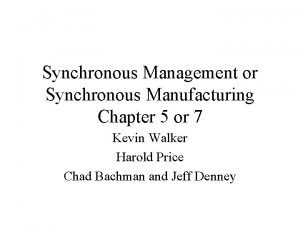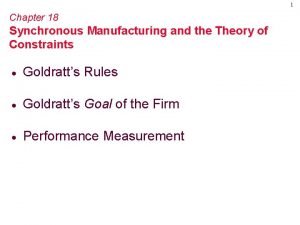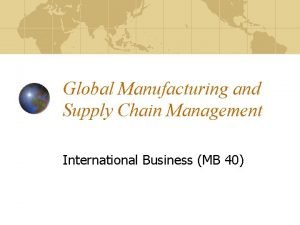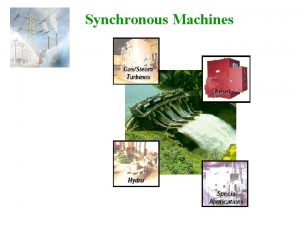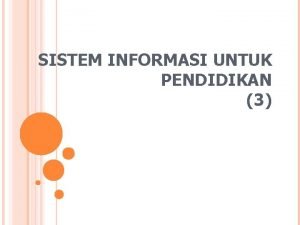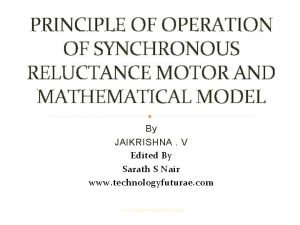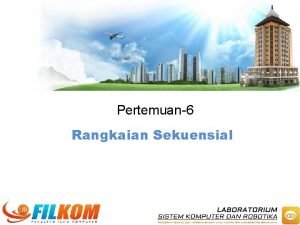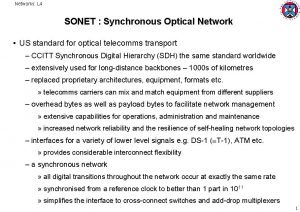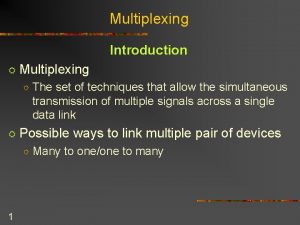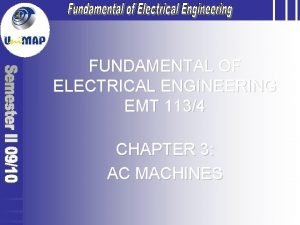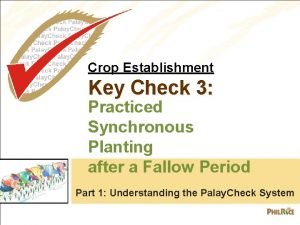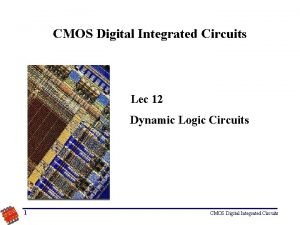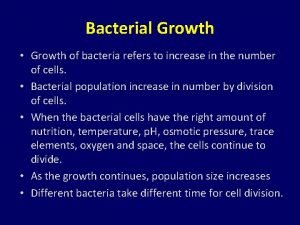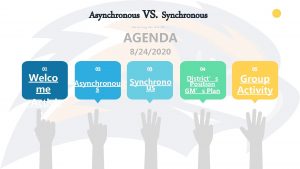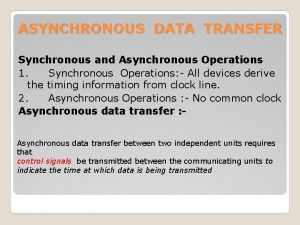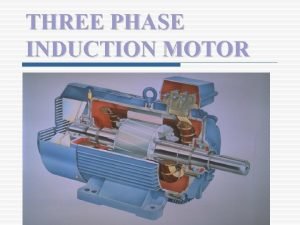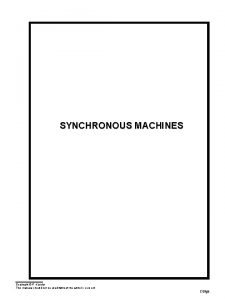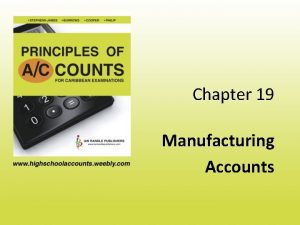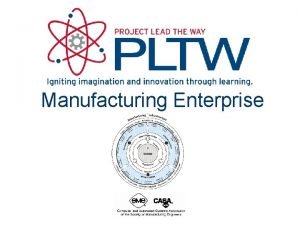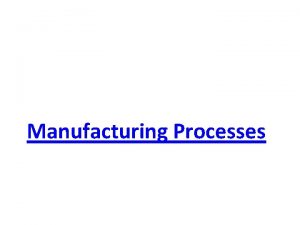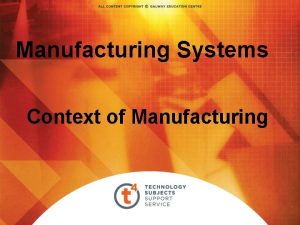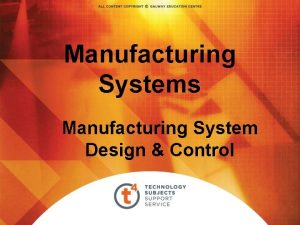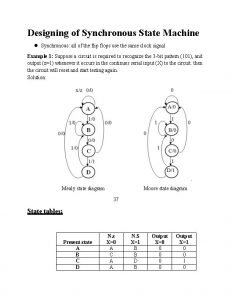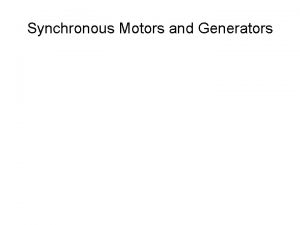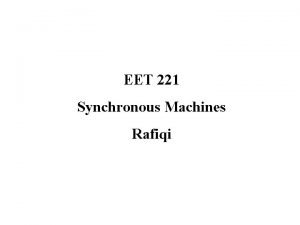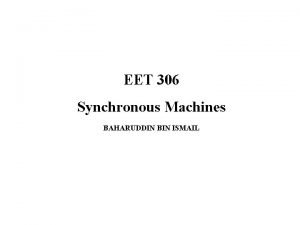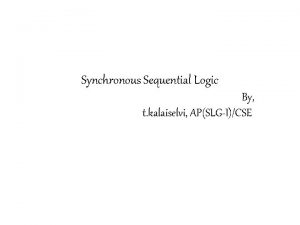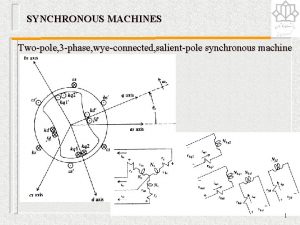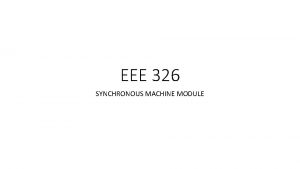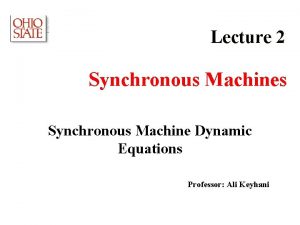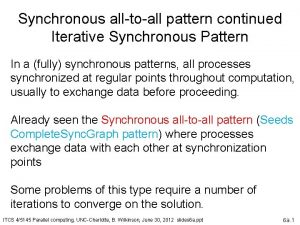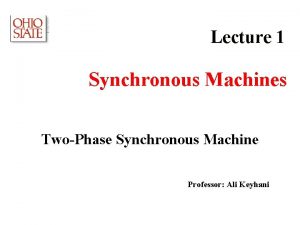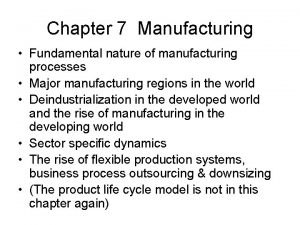Synchronous Management or Synchronous Manufacturing Chapter 5 or




































- Slides: 36

Synchronous Management or Synchronous Manufacturing Chapter 5 or 7 Kevin Walker Harold Price Chad Bachman and Jeff Denney

Evolution of Synchronous Manufacturing • Concept of Waste • What is waste? – Book Definition: Any activity in an organization that does not contribute to the common companywide goal of making money – Waste elimination is a PRIME OBJECTIVE – Everything that is above and beyond what a company needs to be successful

Henry Ford • Definition from Today and Tomorrow – Having a stock of raw materials or finished goods in excess of requirements – Actually included all categories of inventory stock • Component parts, subassemblies, finished goods, materials

Lessons From History • THE FORD SYSTEM VS. • JAPANESE JUST-IN-TIME

Lessons From History • Ford’s Philosophy on Management and Productivity • Fully Integrated Manufacturing System – Eliminated lost motion – Large companies stay within a certain size or it will be uncontrollable-a large plant is not economical!

Ford’s System • Maintaining a Product Flow – Work to the worker not worker to the work – People shouldn’t leave their worksite – Machines do not break down because workers are constantly cleaning and making repairs

Ford’s System • Necessity of Good Material Control – New System-planned a date for changeover – Planned use exact amount of materials to that day-changeover would not cause stop in production – Time Waste VS. Material Waste • You can’t have time salvage • Find the balance of material and time needed

Ford’s System • Role of Quality and Inspection – Key to production is Inspection – It simplifies management • Every part at every stage is inspected-eliminates chance of faulty parts getting into assembly

Ford’s System • Role of Labor – System of Management NOT a system – Is method of planning of what should be done – All workers should follow the plans that are laid out for them • In summary: Ford employed Just-In-Time

Japanese Just-In-Time • Led by Toyota • Used Ford’s methods with some minor improvements • Concept of waste elimination fit well with Japan-has limited resources • JIT Philosophy guided the reduction of scrap, rework, and inventory

Japanese Just-In-Time • Major development in JIT Philosophy – Larger role and responsibility for the worker • Must maintain equipment • Develop new ways to process • Be a problem solver

What went wrong? • Why has U. S. fallen behind in International competition? – No competition meant: • Wasteful practices and unsound policies • Meet demand at any cost – Worldwide competition occurs: • U. S. companies focused on cost • Lost sight of Ford’s lessons of synchronized production flows

Time and Product Value • According to Ford: – Time starts when the raw material comes from the Earth to the moment the customer gets the finished product – More time used for production and sales means less value the product has

The Product Mix • How did Ford achieve efficiency? • “They can have it (car) in any color they want, as long as it’s black” • Continuous Product Flow – Most efficient form of production – Identical products in batch

Philosophy of Sync. Manuf. • Book Definition – An all-encompassing manufacturing management philosophy that includes a consistent set of principles, procedures, and techniques where every action is evaluated in terms of the common global goal of the organization

How Do We Implement It? • 3 Steps – Define the common goal so that it is understandable and meaningful to everyone – Develop what will cause individual actions to relate to the common goal – Manage the various actions to achieve the greatest benefit

A River Analogy • The flow of the river – The water is never stagnant – Water depth is the same as inventory – Boulders and trees impede the flow of material

The Flow of the River (cont. ) • Periods of floods and droughts act as flow problems for the river • Lower water levels keep the stagnant pools smaller. High levels keep the obstacles out of the way

The Flow of the River (cont. ) • In rivers, trees visible above the water level can easily be avoided. In a factory, visible bottlenecks can be used efficiently. • The problem comes when you have a tree hiding just under the surface of the water. • In a factory, bottlenecks can very easily be hidden or just unrecognized.

The Traditional Approach • • Keep “Just in Case” inventory Used to not solve but to cover up problems Gives managers a feeling of security “Just in Case” contradicts “Just in Time”

Traditional Batch Size • Total Setup Costs – Large batch sizes allows less setups • Total Carrying Costs – Small batch sizes allows less work in progress • Economic Order Quantity (EOQ) – The optimum batch size to minimize Total Costs

EOQ Batch Size

Understanding Batch Sizes • Distinction of Resources – Non-Bottlenecks • Extra capacity allows for small batch sizes – Bottlenecks • Time is money and larger batch sizes saves time and money • Single Batch Size Concept – on an assembly line, Batch sizes are BOTH very large and one at a time

Process and Transfer Batches • Process Batch – The quantity of a product processed at a resource before that resource changes over to produce a different product • Transfer Batch – The quantity of units that are moved at the same time from one resource to the next

Synchronous Manufacturing Principles • 1 - Do not focus on balancing capacities, focus on synchronizing the flow • 2 - The marginal value of time at a bottleneck resource is equal to the throughput rate of the products processed by the bottleneck • 3 - The marginal value of time at a non-bottleneck resource is negligible • 4 - The level of utilization of a non-bottleneck resource is controlled by other constraints within the system • 5 - Resources must be utilized, not simply activated • 6 - The transfer batch need not, and many times should not, equal the process batch • 7 - A process batch may be variable both along its route and over time

Just-In-Time Systems • Japanese success due to implementation of just-in-time systems • Concept of Just-in-time systems - Finished good should be produced just in time to be sold, subassemblies should be completed just in time to go into subassemblies, and purchased materials should arrive just in time to be transformed into fabricated parts.

Kanban Systems • Logistical ropes connect the various work stations and drive their JIT systems. • Set up MPS which is determined by market demand. • The projected daily demand for each product is the amount that is scheduled to be produced for that day.

Kanban Systems, cont. • The smoothed production schedule is then set for a fixed period of time-normally one month. • Then final assembly is scheduled in order to meet the daily production requirements.

Kanban Systems, cont. • Toyota, which uses a dual-card kanban system, has its own inbound and outbound material storage areas. *inbound stock area- holds material that is ready for processing at the work station. *outbound stock area- material that has been processed and is stored until needed at the next downstream station.

Kanban Systems, Cont. • Conveyance kanban- a card that identifies needed material, the feeding workstation, and the receiving workstation. • Production kanban- Is the signal and authority for the work station operators to replenish the materials just forwarded to the from the outbound stock area.

Why Kanban systems work • Applies the basic principles of synchronous management. • Principal 1: Do not focus on balancing capacities, focus on synchronizing the flow. • Principle 4: The level of utilization of a non-bottleneck resource is controlled by other constraints within the system. • Principle 5: Resources must be utilized, not simply activated.

Why Kanbans work, cont. • Principle 6: A transfer batch may not, and many times should not, be equal to the process batch. • Principle 7: A process batch should be variable both along its route and over time.

Limitations of the JIT Approach • The number of processes to which JIT logistical systems such as kanban may be successfully applied is limited. • The effects of disruptions to the product flow under a kanban system can be disastrous to current throughput.

Limitations of the JIT Approach • The implementation period required for JIT/kanban systems is often lengthy and difficult. • The process of continuous improvement inherent in the JIT approach is system wide and therefore does not focus on the critical constraints.

**Graph for Chad if he wants**

Chapter 7
 Synchronous management
Synchronous management Synchronous manufacturing and theory of constraints
Synchronous manufacturing and theory of constraints Manufacturing cost vs non manufacturing cost
Manufacturing cost vs non manufacturing cost Process vs job costing
Process vs job costing Controllable expenses examples
Controllable expenses examples Manufacturing cost vs non manufacturing cost
Manufacturing cost vs non manufacturing cost Additive manufacturing vs subtractive manufacturing
Additive manufacturing vs subtractive manufacturing Ramentor
Ramentor Competitive manufacturing management
Competitive manufacturing management Global manufacturing and supply chain management
Global manufacturing and supply chain management Top management middle management first line management
Top management middle management first line management Management pyramid
Management pyramid Top level management
Top level management Three phase synchronous generator
Three phase synchronous generator Cylindrical
Cylindrical Synchronous area framework agreement
Synchronous area framework agreement Pembelajaran synchronous dan asynchronous
Pembelajaran synchronous dan asynchronous Pembelajaran synchronous dan asynchronous
Pembelajaran synchronous dan asynchronous Synchronous reluctance motor torque equation
Synchronous reluctance motor torque equation Synchronous sequential circuits examples
Synchronous sequential circuits examples Synchronous optical network (sonet)
Synchronous optical network (sonet) Fdm
Fdm Any size
Any size Keycheck
Keycheck Synchronous vs asynchronous programming
Synchronous vs asynchronous programming Cmos leakage current
Cmos leakage current Multilevel multiplexing
Multilevel multiplexing 2 bit counter
2 bit counter Synchronous vs asynchronous data transfer
Synchronous vs asynchronous data transfer During the lag phase, bacteria are
During the lag phase, bacteria are Synchronous activities examples
Synchronous activities examples Asynchronous data transfer handshaking
Asynchronous data transfer handshaking Synchronous
Synchronous Synchronous and asynchronous i/o
Synchronous and asynchronous i/o Synchronous speed of motor
Synchronous speed of motor Synchronous media
Synchronous media Machine dynamics
Machine dynamics
